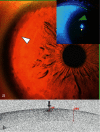Comparison of Different Types of Corneal Foreign Bodies Using Anterior Segment Optical Coherence Tomography: A Prospective Observational Study
- PMID: 32850143
- PMCID: PMC7439195
- DOI: 10.1155/2020/9108317
Comparison of Different Types of Corneal Foreign Bodies Using Anterior Segment Optical Coherence Tomography: A Prospective Observational Study
Abstract
Purpose: The present study highlighted the value of anterior segment optical coherence tomography (AS-OCT) for different types of corneal foreign bodies in humans.
Methods: This study was a prospective observational study. The patients included were divided into two groups. If the patients were directly diagnosed based on eye injury history and slit-lamp examination, then they were assigned to Group A. Otherwise, the patients were assigned to Group B. We compared and described the characteristics of the corneal foreign body in both groups using AS-OCT.
Results: From October 2017 to January 2020, 36 eyes of 36 patients (9 females and 27 males) with a mean age of 37.8 ± 11.7 years were included in the study. Patients in Group A were the majority and accounted for 72.2% (26/36). High signals on AS-OCT images were the main constituent and accounted for 92.3% (24/26) in Group A and 70.0% (7/10) in Group B. Most of the patients in Group A, 96.2% (25/26), had clear boundaries. A blurred boundary was observed in 70.0% (7/10) of the patients in Group B. The foreign bodies on AS-OCT images had key characteristics of a high signal followed by a central zone shadowing effect and a low signal followed by a marginal zone shadowing effect. Further, all of the lesions could be directly located in Group B, and 92.3% (24/26) of the patients in Group A did not have directly located lesions. Six representative cases are described in detail.
Conclusions: AS-OCT is a valuable tool in the diagnosis and management of corneal foreign bodies, especially for unusual corneal foreign body.
Copyright © 2020 Tao Wang et al.
Conflict of interest statement
The authors declare that they have no conflicts of interest.
Figures






Similar articles
-
Anterior segment optical coherence tomography in eye injuries.Graefes Arch Clin Exp Ophthalmol. 2009 Apr;247(4):451-5. doi: 10.1007/s00417-008-0937-x. Epub 2008 Sep 3. Graefes Arch Clin Exp Ophthalmol. 2009. PMID: 18766361
-
The role of anterior segment optical coherence tomography in the management of an intra-corneal foreign body.Springerplus. 2016 Sep 13;5(1):1559. doi: 10.1186/s40064-016-3242-x. eCollection 2016. Springerplus. 2016. PMID: 27652132 Free PMC article.
-
Evaluation of the Cornea by Anterior Segment Optical Coherence Tomography in Diseases of the Cornea.Cureus. 2024 Sep 23;16(9):e70036. doi: 10.7759/cureus.70036. eCollection 2024 Sep. Cureus. 2024. PMID: 39449878 Free PMC article.
-
[New diagnostic methods for imaging the anterior segment of the eye to enable treatment modalities selection].Nippon Ganka Gakkai Zasshi. 2011 Mar;115(3):297-322; discussion 323. Nippon Ganka Gakkai Zasshi. 2011. PMID: 21476312 Review. Japanese.
-
The Value of Anterior Segment Optical Coherence Tomography in Different Types of Corneal Infections: An Update.J Clin Med. 2021 Jun 27;10(13):2841. doi: 10.3390/jcm10132841. J Clin Med. 2021. PMID: 34199039 Free PMC article. Review.
Cited by
-
Commentary: Anterior segment optical coherence tomography characteristics and management of unique spectrum of foreign bodies in cornea and anterior chamber.Indian J Ophthalmol. 2022 Dec;70(12):4293-4294. doi: 10.4103/ijo.IJO_2259_22. Indian J Ophthalmol. 2022. PMID: 36453331 Free PMC article. No abstract available.
-
Insect wing case corneal foreign body: ASOCT-based findings.BMJ Case Rep. 2022 Aug 23;15(8):e251578. doi: 10.1136/bcr-2022-251578. BMJ Case Rep. 2022. PMID: 35999021 Free PMC article. No abstract available.
-
Anterior Segment Optical Coherence Tomography-Assisted Surgical Planning for Removal of a Corneal Foreign Body: A Case Report and Literature Review.Tunis Med. 2024 Nov 5;102(11):955-959. doi: 10.62438/tunismed.v102i11.5209. Tunis Med. 2024. PMID: 39564643 Free PMC article. Review. English.
-
Anterior segment optical coherence tomography characteristics and management of a unique spectrum of foreign bodies in the cornea and anterior chamber.Indian J Ophthalmol. 2022 Dec;70(12):4284-4292. doi: 10.4103/ijo.IJO_878_22. Indian J Ophthalmol. 2022. PMID: 36453330 Free PMC article.
-
The efficacy of autologous serum in corneal healing following metallic foreign body injuries.Graefes Arch Clin Exp Ophthalmol. 2025 Jun 11. doi: 10.1007/s00417-025-06866-x. Online ahead of print. Graefes Arch Clin Exp Ophthalmol. 2025. PMID: 40498153
References
-
- Guier C. P., Stokkermans T. J. StatPearls. Treasure Island, FL, USA: Treasure Island (FL): StatPearls Publishing; 2020. Cornea foreign body removal. - PubMed
LinkOut - more resources
Full Text Sources
Research Materials

